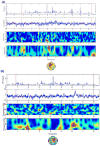Neural basis of postural instability identified by VTC and EEG
- PMID: 19655130
- PMCID: PMC2942764
- DOI: 10.1007/s00221-009-1956-5
Neural basis of postural instability identified by VTC and EEG
Abstract
In this study, we investigated the neural basis of virtual time to contact (VTC) and the hypothesis that VTC provides predictive information for future postural instability. A novel approach to differentiate stable pre-falling and transition-to-instability stages within a single postural trial while a subject was performing a challenging single leg stance with eyes closed was developed. Specifically, we utilized wavelet transform and stage segmentation algorithms using VTC time series data set as an input. The VTC time series was time-locked with multichannel (n = 64) EEG signals to examine its underlying neural substrates. To identify the focal sources of neural substrates of VTC, a two-step approach was designed combining the independent component analysis (ICA) and low-resolution tomography (LORETA) of multichannel EEG. There were two major findings: (1) a significant increase of VTC minimal values (along with enhanced variability of VTC) was observed during the transition-to-instability stage with progression to ultimate loss of balance and falling; and (2) this VTC dynamics was associated with pronounced modulation of EEG predominantly within theta, alpha and gamma frequency bands. The sources of this EEG modulation were identified at the cingulate cortex (ACC) and the junction of precuneus and parietal lobe, as well as at the occipital cortex. The findings support the hypothesis that the systematic increase of minimal values of VTC concomitant with modulation of EEG signals at the frontal-central and parietal-occipital areas serve collectively to predict the future instability in posture.
Figures








Similar articles
-
EEG correlates of postural audio-biofeedback.Hum Mov Sci. 2011 Apr;30(2):249-61. doi: 10.1016/j.humov.2010.05.016. Epub 2010 Aug 30. Hum Mov Sci. 2011. PMID: 20800912
-
The virtual time to contact in the evaluation of balance disorders and prediction of falls in people with multiple sclerosis.Disabil Rehabil. 2012;34(6):470-7. doi: 10.3109/09638288.2011.608144. Epub 2011 Oct 10. Disabil Rehabil. 2012. PMID: 21985076
-
Modulation of cortical activity in response to visually induced postural perturbation: combined VR and EEG study.Neurosci Lett. 2013 Jun 28;547:6-9. doi: 10.1016/j.neulet.2013.05.001. Epub 2013 May 9. Neurosci Lett. 2013. PMID: 23665528 Free PMC article.
-
Visual target modulation of functional connectivity networks revealed by self-organizing group ICA.Hum Brain Mapp. 2008 Dec;29(12):1450-61. doi: 10.1002/hbm.20479. Hum Brain Mapp. 2008. PMID: 17990304 Free PMC article.
-
Cortical dynamics during preparation and execution of reactive balance responses with distinct postural demands.Neuroimage. 2019 Mar;188:557-571. doi: 10.1016/j.neuroimage.2018.12.045. Epub 2018 Dec 24. Neuroimage. 2019. PMID: 30590120
Cited by
-
An Increase in Postural Load Facilitates an Anterior Shift of Processing Resources to Frontal Executive Function in a Postural-Suprapostural Task.Front Hum Neurosci. 2016 Aug 19;10:420. doi: 10.3389/fnhum.2016.00420. eCollection 2016. Front Hum Neurosci. 2016. PMID: 27594830 Free PMC article.
-
The 3D Bioprinted Scaffolds for Wound Healing.Pharmaceutics. 2022 Feb 21;14(2):464. doi: 10.3390/pharmaceutics14020464. Pharmaceutics. 2022. PMID: 35214197 Free PMC article. Review.
-
Higher Balance Task Demands are Associated with an Increase in Individual Alpha Peak Frequency.Front Hum Neurosci. 2016 Jan 6;9:695. doi: 10.3389/fnhum.2015.00695. eCollection 2015. Front Hum Neurosci. 2016. PMID: 26779005 Free PMC article.
-
Postural orientation and equilibrium processes associated with increased postural sway in autism spectrum disorder (ASD).J Neurodev Disord. 2016 Nov 25;8:43. doi: 10.1186/s11689-016-9178-1. eCollection 2016. J Neurodev Disord. 2016. PMID: 27933108 Free PMC article.
-
Cortical Correlates of Human Balance Control.Brain Topogr. 2017 Jul;30(4):434-446. doi: 10.1007/s10548-017-0567-x. Epub 2017 May 2. Brain Topogr. 2017. PMID: 28466295 Free PMC article.
References
-
- Aftanas LI, Pavlov SV, Reva NV, Varlamov AA. Trait anxiety on the EEG theta band power changes during appraisal of threatening and pleasant visual stimuli. Int J Psychophysiol. 2003;50(3):205–212. - PubMed
-
- Barin K. Dynamic posturagraphy analysis of error in force plate measurement of postural sway. IEEE Eng Med Biol. 1992;11:52–56.
-
- Basar E, Basar-Eroglu T, Demiralp T, Schurmann M. Time and frequency analysis of the brain’s distributed gamma band system. IEEE Eng Med Biol. 1995;14:400–410.
-
- Boiten F, Sergeant J, Geuze R. Event-related desynchronization: the effect of energetic and computational demands. Electroenceph Clin Neurophysiol. 1992;81(4):302–309. - PubMed
-
- Botvinick M, Braver T, Barch D, Carter C, Cohen J. Conflict monitoring and cognitive control. Psych Rev. 2001;108:624–652. - PubMed
Publication types
MeSH terms
Grants and funding
LinkOut - more resources
Full Text Sources
Medical
Miscellaneous

